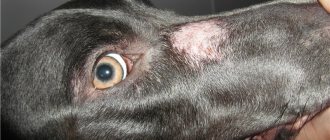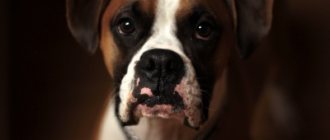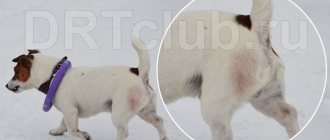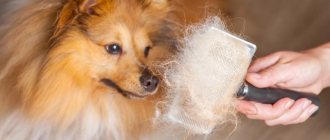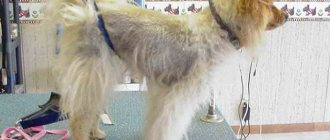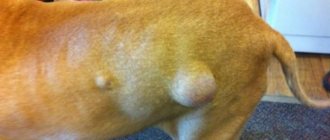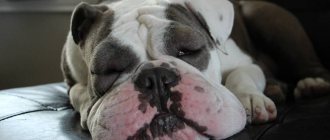Bald spots in dogs (alopecia) is an alarming symptom that should attract the attention of every pet owner. Although sometimes this symptom is not dangerous and can only be caused by an allergy to a substance contained in a cosmetic or even a food ingredient, you should first make sure that your pet is not in danger.
Especially, alopecia in dogs can often be associated with a serious illness - in this case, a quick response to alarming symptoms will be decisive for the further development of the event. The sooner we inform the veterinarian, the faster he will be able to determine the cause of the dog’s bald spots and carry out the appropriate procedures.
Bald patches in dogs: common causes and treatments
There are many reasons why dogs can lose hair (also called alopecia), from infection to irritation caused by parasites. Here are some of the most common reasons:
Allergies
Allergies are a common cause of hair loss in dogs. Just like people, dogs can have allergic reactions to food, environmental triggers such as pollen, or parasites such as fleas or ticks.
However, flea bites are the cause of most allergies in dogs. In addition to hair loss due to licking and biting irritated areas, signs of a flea allergy include itching and redness. In a dog with specific allergies, it may take just one flea bite to cause an allergic reaction that lasts several days.
Although any dog can have allergies, some are more prone to them than others. Treatment for your dog's allergies may include topical or internal medications, allergy shots, diet changes, and allergen avoidance.
Prevention
To keep your pet's fur healthy, it is necessary to balance the dog's diet and enrich the diet with bioactive additives (fatty acids, B vitamins, amino acids, brewer's yeast, biotin). Also, we must not forget about activity. Your pet needs fresh air, active walks, games and attention from the owner. Do not forget to periodically thoroughly comb the dog, inspect the integrity of the skin and monitor the general condition of the animal. There are special vitamin and mineral complexes to improve the quality of dog fur.
Cushing's disease
Hair loss in dogs can also be caused by hyperadrenocorticism or Cushing's disease, a condition caused by overproduction of the hormone cortisol. Medicines and sometimes surgery are available to treat Cushing's disease, also known as Cushing's syndrome.
Cushing's disease is most common in dogs 6 years of age and older. Other signs of Cushing's disease include frequent eating, drinking and urination, shortness of breath, and a pot-bellied appearance. If you notice any of these signs, take your dog to the vet.
Pet grooming
To quickly cope with this disease, it is extremely important to provide the dog with proper and complete care at home. It provides:
- Complete feeding of your pet. During the treatment period, it is recommended to give the dog food with a high content of vitamins, and to completely exclude from the menu all foods that can provoke allergies.
- Providing your pet with adequate rest and protection from stress. In case of infectious diseases, it is recommended to refrain from walking in public places and avoid contact with other animals, especially wild ones. If the dog lives in an enclosure, in a kennel, it is recommended to take him into the house and keep him there until he fully recovers.
- Use of a special protective collar. This remedy is used for severe itching to prevent the animal from scratching the skin. Effective if bald spots appear under the collar, on the face, around the eyes or ears.
- Regular brushing of your pet. Remember that fallen fur greatly irritates the skin and provokes intense shedding.
- The use of local drugs to relieve symptoms of pathology. If your doctor has not prescribed you an ointment, you can use olive oil for this purpose.
- Using special shampoos for bathing dogs. They must be selected by a veterinarian.
It is also extremely important to exclude the possibility of re-infection of the dog with parasites, pathogenic bacteria or fungi. To do this, you should treat the animal’s bedding (or replace it with a new one), its toys, bowls, and combs. The same should be done with the personal belongings of other animals living in the house.
Pregnant and lactating bitches suffering from hair loss should be provided with an enhanced diet. General medications are not used for such individuals, as they can negatively affect the development of the offspring. Sick puppies that have inflammation of the glands should be isolated from the rest of the litter. Otherwise, other babies can quickly catch an infection from them.
This type of care is provided until the dog fully recovers. After the symptoms of the disease disappear, he is again shown to the veterinarian. If he is satisfied with the condition of the animal, you can return to the normal rhythm of the animal’s life, remove restrictions on walking and choose a simpler diet for him.
Video: why does a dog lose hair, and what to do about it?
[custom_ads_shortcode2]
Genetics
There are some "hairless" dogs, such as the Chinese Crested and the Mexican Hairless, but some dogs are more prone to hair loss than others. Hairless patches on the outer ear, chest, belly, hips, or lower neck can appear in Greyhounds, Beagles, Chihuahuas, Dachshunds, and Italian Greyhounds, usually after the first year of life.
Most owners learn to live with it as treatment options are limited. Always check to see if your veterinarian has ruled out other causes of hair loss.
How is the diagnosis carried out?
Diagnosis of hormonal disorders is carried out on the basis of an analysis of hormone levels in the blood serum, as well as a visual examination of the pet and a survey of the owner about the peculiarities of the animal’s behavior.
Additionally, the following may be prescribed:
- general clinical analysis of blood and urine;
- ECG;
- Ultrasound;
- radiography.
Infectious diseases and allergies are diagnosed based on tests. And to diagnose external parasites, a visual examination is often sufficient, but smears may be taken. Ringworm is diagnosed using a Wood's lamp. In its light, fungal spores begin to glow in ultraviolet color. But to be sure, the veterinarian will conduct an additional bacteriological study.
Infection or infestation (ringworm, mites, bacteria)
Ringworm, pests like scabies mites, and bacteria can all lead to infections that can eventually cause bald spots on your dog.
In addition to hair loss around the ears, eyes, mouth and other areas, your dog may have mite problems including oily skin, thickened skin, itching and inflammation. Symptoms of ringworm, a contagious infection of the hairy skin and nails, include circular or irregular hair loss, inflammation and infected crusts.
Although small ringworm lesions may go away spontaneously, they are contagious and require treatment. Ringworm is treated with topical antifungal medications. In severe cases, oral antifungal medications may be required.
Treatment for mites may require topical or oral medications, as well as antibiotics for secondary bacterial infections.
Preventive actions
The best way to combat skin pathologies is their prevention. To protect your four-legged friend, you need to take care of antiparasitic treatment and strengthen his immunity.
Planned treatment against ectoparasites
The treatment schedule for ectoparasites depends on the chosen product. Drops and sprays last the longest. It is enough to apply them only once a month.
It is better to spray sprays daily. They evaporate quite quickly and do not always reach the epidermis through too thick coat.
Maximum activity of ticks and other parasites is recorded from April to October. At this time, it is recommended to add collars to the listed drugs. In the absence of allergies, they are worn on a regular basis.
Bedsores
Older or heavier dogs may be predisposed to bedsores when their elbows or other bony parts of the body regularly come into contact with hard surfaces. Over time, constant pressure leads to thickening of the skin, hair loss and calluses.
If calluses crack, bleed, or become infected, treatment may include moisturizers, antibiotics, or the use of retainers. You can prevent bedsores and calluses by providing your dog with soft bedding.
Vitamins and preparations for hair restoration
A healthy dog has a beautiful, thick, even coat with bright color and shine. To ensure your pet’s appearance remains impeccable, its cover must be carefully monitored:
- Bath and brush according to breed recommendations;
- Use only animal-friendly products;
- Follow a diet, choosing high-quality products and feeds without allergenic additives.
During the shedding period, be sure to brush your dog daily to get rid of dead hair. Without this procedure, the pores become clogged, which leads to itching and irritation. If any unhealthy signs appear: bald spots, redness, you need to go to the clinic.
Another factor influencing the health of the coat is the sufficiency of the vitamin complex. All puppies and adult dogs need mineral supplementation. If dry food includes the necessary vitamins, then special additives are introduced for natural nutrition.
There are industrial wool growth tablets and nutritional supplements:
- Vit active S-SH (increasing hair density, improving structure; preventing destruction of hair follicles);
- Beafar (vitamin complex for healthy dermis and coat);
- Excel 8 in 1 (combination of garlic and brewer's yeast);
- Varieties of vitamins Canina ;
- Feed molasses and liver, flaxseed oil, brewer's yeast, lamb, whey (vitamins B, H, F);
Other causes of bald spots in dogs
Foreign body reaction
Glass, wood chips, and sharp debris can cause inflammation if they come into contact with your dog's skin. Along with hair loss, signs of foreign body irritation include swelling and repeated licking of the area, such as between the toes.
Treatment may require lancing under local or general anesthesia to remove the irritant and antibiotics if there is a secondary bacterial infection.
Baldness after haircut
In some dogs, especially thick-coated breeds such as Alaskan Malamutes, Siberian Huskies and Keeshonds, trimming—for example, in preparation for surgery—can lead to permanent bald spots. A fairly common condition, there is really no cure for post-haircut baldness other than patience while the hair grows back.
Hypothyroidism
With hypothyroidism, the thyroid gland does not produce enough of the hormone thyroxine, which controls metabolism. This affects your dog's coat and can lead to hair loss.
Affects all breeds, but is common in Golden Retrievers, Doberman Pins, Irish Setters, Dachshunds, Boxers and Cocker Spaniels.
It usually occurs in middle-aged dogs (4 to 10 years old) of medium and large breeds. Spayed males and neutered females also have a higher risk, but veterinarians don't know why.
What is alopecia?
This is hair loss in animals. It may be associated with the natural change of hair coat - molting, but often takes on pathological forms in which the animal experiences baldness of certain parts of the body, the appearance of ulcers and inflammations, as well as tissue pigmentation. Such individuals often have a “fur coat” that comes out in tatters. Such a symptom almost always indicates serious malfunctions in the body’s functioning - hormonal changes, disruption of the functioning of internal organs, or infection of the pet with parasites.
When such a problem arises, the dog owner needs to remain calm. If he notices moderate hair loss in the spring or fall, there is no need to worry. However, if this process begins in winter and is accompanied by a general deterioration in the dog’s condition, the appearance of islands of bare skin on the paws, face, and stomach, you should consult a veterinarian. In most cases, a specialist is able to cope with such a scourge quickly without consequences for the animal’s health.
[custom_ads_shortcode1]
How to relieve severe itching
Itching is a good reason to visit a veterinarian. If your pet starts itching after new food, shampoo, bedding, or the product you used to clean the house, then you need to return to the original food or detergents. Eliminating the source of the allergy or stress will normalize the animal’s condition in a couple of days.
You can get advice from a veterinarian and prescribe one of the antihistamines, for example, Suprastin or Tavegil. Or wait until the body copes with the allergy on its own, if there is no severe itching.
In the long term, antihistamines do not promote good immune system function. They act like turning off a fire alarm without affecting the fire itself. The second reason is parasites. Carefully examine the animal's fur. If you find fleas or lice, wash your dog with anti-flea shampoo “Fitoelita”, “Bars”, “Mr Bruno”, “Doctor Zoo”, “Clandestine”.
The next reason is inflammation. Wash the inflamed area with chamomile infusion or green tea with 1/2 teaspoon of apple cider vinegar. You can also apply a thick poultice of oatmeal to the itchy area. Now you have done everything you could. And if the problem persists, then after providing first aid to your pet and eliminating the most obvious causes of itching, you are ready to get an appointment with a veterinarian.
